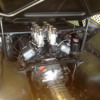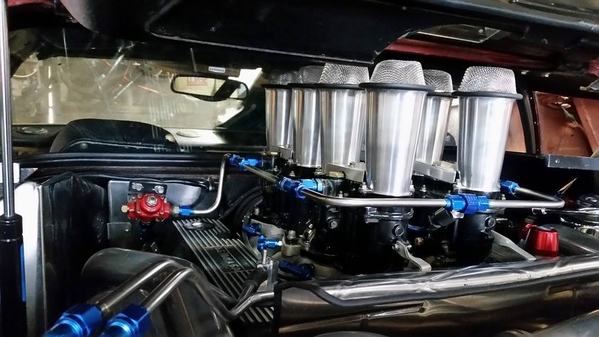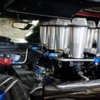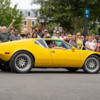all of the weber aircleaners look bad or don't function well. What is your though about not using any for the short trips to shows etc.
Replies sorted oldest to newest
Weber air cleaners on a V8 engine do not last long. What happens is that the natural fuel reversion soaks the filter element and will catch fire on a restart.
Generally speaking you never use filter elements on 48ida's on a V-8. It just doesn't work.
Use screens and since air flow restriction is a function of surface area, try to maximize the screen surface areas.
I have a bunch of friends running them on 289 Cobras. One of them ran them without screens on his Cobra which he drove regularly for 28 years without anything on the stacks at all.
If you notice, the Group 4 factory race cars that ran Webers used extended velocity stacks that wound up around 5" high in total. That did two things. One was to change the torque curve of the engine somewhat to make using 44mm "auxiliary venturis" more useable and 2) it kept the "cloud" of fuel vapor within the velocity stacks rather then having it wonder all over (for the most part anyway).
It is possible to limit the reversion, but not to completely eliminate it with revised cam timing. Jim Inglese initially experimented with that and basically for the Cleveland there is one cam, a hydraulic lifter one still offered by CompCams that they refer to as the "Weber Cam".
The problem with that one is it doesn't entirely eliminate the reverson and it kills around 100 hp that ordinarily would be available in a conventional longer duration, bigger overlap design.
The magic number with a Cleveland and dealing with reversion is limiting overlap to under a total of 28°. If you look at the timing specs on a stock Ford CJ cam, the overlap listed is right there at 28°. So some guys still running that cam and adding Webers have no idea WTF I'm talking about with either the reversion or air cleaner issues.
"C'est la vie", say the old folks. It goes to show you never can tell- Chuck Berry. ![]()
Attachments
I like your answer and agree with all you say. Weber’s are just too cool to cover and the relatively few miles most of us drive these cars can’t eat up our motors from the rust.
Famous last words?
Tom
That last sentence was to say from dust, not rust.
Speaking of rust, my car has not been washed in the 43 years I’ve owned it, but got wet one time from an unexpected rainstorm. It’s pretty clean.
Attachments
Those little screens on top of Webers are often called 'Bird Catchers'. They also come in handy for stopping urchins from dropping pennies or marbles in open Webers. Air cleaners catch all kinds of debris.... Note- anyone that uses air cleaners on Webers should avoid paper air filters due to the reversion mentioned before. PAPER filters will soak up gas from the reversion, and then you're one backfire-when-cold from a stack fire. So I especially recommend a fire extinguisher on Weber-equipped engines. DeTomasos should carry one just for insurance.
The Pantera has a similar "air chamber" created by the location of the engine and transmission as the GT40's do.
It is much less likely to suck in candy wrappers, squirrel tails or road pebbles then a front engine car does.
The first time I heard the word "urchin" used was on an episode of "Firing Line" where Bill Buckley and Gore Vidal were going at it heavily as usual. I gathered that it was largely a Roman expression that was used to describe unfavorably non-Italians that lived in Rome and were grab and run gangsters.
In using it here once, it was taken by some as a racial disparaging remark against Italians. It has since been dropped from my vocabulary use list. For me, that's a difficult loss since my usable vocabulary is barely 100 words now as is?
It isn't just paper filter elements that absorb the "atomized fuel" it is the cloth fabric and foams as well. The foams don't even burn, the seem to just instantly vaporize.
The frustrating thing is that IDA's have been run on other engines with filters with no issues. The 911-s Porsche is a good example and there are bunches of Lamborghinis like the Miura S and Ferrari 365 GTB Daytonas that were built with them.
The significant factor here is that V8 engines naturally have a reverse pulse into the induction that a 4, 6. or 12 cylinder engine does not produce. I don't know about the 10's in the Vipers though?
When you have a single intake plenum with a single or even multiple carb induction on a V8, the reverse pulse is used to push fuel into the next charging cylinder. IDA's use an individual runner intake sysetem.
Incidentally, the first induction system used on the 69 Shelby Boss 302 Trans Am race car also used an individual runner induction system using two Holley Dominator carbs mounted sideways and had the same reversion issues. The dual Autolite In-line carbs using two on the same engine...same thing...reversion.
The Pantera actually has an advantage here with an IR system in that it has enough room available over the top of the carbs to use taller stacks to retain the vapor cloud within the stack. Very much like the GT40's in that respect.
The IDA was never conceived of as a "street production" carburetor. It was conceived of by Carroll Shelby in order to put on his Cobras so they could have the same advantages of those "Eye-talian" cars did.
They were financed by Ford and built for Ford by Weber. That continued with a very limited set of 58 IDA's also built for Shelby to run on the Mark II 427 GT40's to "beat Ferrari's Ass" at Lemans. The big ones never quite worked out though probably because of this reversion issue and are now VERY valuable antiques and collectables.
Does anybody know when the 48IDAs were first produced and applied to cars?
At the very first application they were 46 IDA's and show up in 1962 as sand castings. Some time in '63 they became 48's and shortly after became pressure cast.
I believe though that the first sand cast versions were called IDF's.
Initially they were serial numbered and those are what you would find on Cobras from the '60s.
The versions used on the Panteras were the '70s versions with date codes on them.
My Italian built Webers have 48 IDA 4 1J stamped on them. They were bought from Hugh Kleinpeter who raced them in 1974, and have been on my car ever since. Can anybody interpret the stamp?
Attachments
Yes. They are 48IDA 4's, which are the last iteration of the IDA. The only difference with the "4's" v "1's" is the "auxiliary venturi". (I've never seen 2's and 3's). That's the changeable choke in them. The first two IDA's were listed as being for the GT40 and were built/assembled with 42mm "chokes". The "4's" were built with 37mm chokes.
The 1J is the date they were made. October 1971.
It's mostly the "Cobra" guys that are looking for '60s dated carbs. Until maybe 20 years ago, no one cared. The only differences are the dates since they are all of a modular construction.
The biggest user of them at that point were VW's mostly in Dune Buggies.
They are all made in Italy up to somewhere in the '80's or '90s when they were made in Spain, then somewhere in this century had the country completely blank.
The only real difference is that the top and bottom were originally held together with a stud and nut on top. The Spanish ones replaced that with just a bolt. The other differences are just the size of the choke they came with and the calibration, i.e., fuel jet, air jet, emulsioln tube, idle holder and idle fuel jet, which are all almost infinitely changeable.
The unique component to your setup is the intake manifold which is unique to the Pantera racing program in Europe where multiple carburetion was legal in the factory classes.
Speculation on production numbers of that manifold are probably 100. Where the rest of them are, no one knows. Only a few have ever shown up for sale.
Carb copies are now being made in China with no indication of where they were made. Some are being bored out to 51mm mostly to use on rotary Mazdas now.
One of mine has a separate bolt-in choke mechanism. It seem that choking only one of four is sufficient for cold starts.
Mine do not need a choke. Two or three pumps cold and it fires up.
Some "tuners" change the accellerator pump check valve for a smaller orifice.
I remember during my initial "tuning" I had them reduced down to a .5. I ran out of time and light that day and put the car away for the night. The next day when I went to start it cold, it wouldn't fire. It seems that I had reduced the pump shot down too much.
The pumps are "heavy" as supplied new. I think they are stock with either 2.0 or 1.5's? If you leave them stock, you don't need a choke to cold start the engine.
Lots of these details had to be learned by me the hard way. NO ONE knew these details OR just wouldn't share them in '77 or '78 when I was crazy enough to do this on my own. I did have the help of Jim Inglese though. He "leant" me all the fuel jets and air jets I needed with the understanding that when I got the tune right I would only share the information with him.
It seems that the Clevelands are from a different "Universe" then the 289's and 427's are and I was the test mule. There were some like Kleinpeter that had the information but to most back then that was all proprietary information and kept under lock and key in a safe.
I fussed with those Kleinpeter Webers for years. The two-progression hole version was never good near idle, so two years ago I bought a new three progression hole set and all is finally well. I still own a bag full of jets etc.
I have researched the Holman Moody built DeTomaso Weber manifolds extensively and found several of answers regarding their numbers. No two were the same. Because they are rather thin walled and fragile, they tended to break easily during installation. No telling how many survived. I know of two, one of which is mine. Hugh Kleinpeter had his machined into two halves so the two sides were independent of each other.(see attached)
I would not buy a Chinese set of Webers, if that's where they come from now. My experience with Chinese parts has not been good.
Attachments
Thanks, Doug. I have a brand new set of 48DCOEs in the shop, and a partially completed side-draft intake manifold. Then life got in the way and I never finished it for the Pantera. But I ran a pair of adapted 40IDA 3-C Webers on my street Corvair for a decade, and they needed a choke not just for starting but until the thing was thoroughly warmed up. Or I got occasional bucking and popping. That was also the case with 40TIN Zenith 3-bbl weber-lookalikes.
My experience, as well as several San Jose Porsche owners with downdraft Webers: if you run paper or especially foam air cleaners and get a stack fire, the long aux venturis are cast pot metal and will instantly MELT. The molten metal then gets sucked down the intake and past any open intake valves into the combustion chamber. Then it solidifies.
On the next stroke, the pot-metal lump get pinched between the bottom of the piston & the squish area in the head, and cracks the piston, also breaking the top ring & maybe scoring that cylinder. So I had to overhaul the engine because of a backfire. IMHO, K & N oiled fiber air filters are not as good as paper at cleaning the air, but they don't soak up reversion gas either. That's what the Nor Cal air cooled Porsche guys use.
Like you, I found in the '70s there was no such thing as a specialty carb place. Most were racing teams or an occasional dyno shop. Good carbs, adjustable-everything but parts were/are expensive. Five jets, two air bleeds, a replaceable main venturi and replaceable emulsion tube- FOR EACH CYLINDER! Easy to get lost in the possibilities. Today I would be good friends with Jim Inglese and a local dyno shop instead of DIY.
FYIW, Weber started making 8-stack EFI systems when they stopped making carbs. I saw one set running on a Swiss Longchamp at one of the factory reunions in Italy. Don't know anything about them, though except they exist. I'll bet Roland in Germany does, though.
I got out of Corvairs in 71. The simplest would be to use the 140 two carb heads but it was nothing to send a kid up in a crate like that.
Jim is a funny guy. It's always a love hate relationship with him and I outgrew needing him thirty years ago. He's more of a bling guy and needs everything chromed.
Tom. A third transition hole is a very simple thing to do. Why they were never installed from the beginning is really a mystery to me. I want to be fair to all involved and say that 48ida's on a 289 Ford was an experiment from the beginning and the advantage for me of following all the seemingly haphazard developments through racing helped me get a perspective on the "necessity is the mother of invention" thing and not to be affraid to have my own designs even if they fail miserably and make me look like a fool. The other side to that is some of the simplest things make you look like an understating genius. It all goes with the territory.
The fact of the matter is most folks will never have the fogiest idea WTF you are talking about anyway and you have to be willing to use (steal) someone else's ideas and not be afraid of the "not invented here syndrome".
The solution to all the issues of an IR manifold with carburetors is to go to an EFI system. The current "Holley Eight Stack" is a Weber counterfeit with hidden fuel injectors within. FI is not subject to fuel reversion since there is no fuel held in suspension in the throttle bodies throats like in a carb. So there is nothing for it to blow out.
The problem with that system is it is at least $8,000 on your manifold. I would want to put two equally built Clevelands on a dyno. One with the carbs. The other with the EFI and compare them rpm per rpm. I've got a sneaking suspicion that the carbs are more responsive and make more power up top?
I already know the EFI is cleaner at idle. No comparison there.
Tom. When I bought my Weber manifold from Hall in '76 or '77, the "thin" part was exactly the discussion I had with Gary about the Detomaso part.
I actually talked to Kleipeter about buying his car around then. Gary laughed and told me stay away from it and buy a real Pantera. Kleinpeter reminded me of the "Mad Hatter" in "Alice in Wonderland".
Truths are truths. Some times haunting in retrospect and sometimes come back and haunt you?
Boss: Inglese had the DCOE sidedrafts working on his 66 GT350. They were on the car when he blew up the engine at about 8,500 rpm's in front of the ice cream shop in New Jersey at the SAAC 10 Convention at the former Playboy club. I never saw him run those again. You can't get the valve covers off unless you take the carbs off.
I'm still happy with this type of a delusion. It keeps me away from what looks like a mass delusion going on in some circles these days.
It's interesting to hear from you about your approach to things. I'm a do-it yourselfer and my Pantera has only been touched once by a professional engine builder. There is nothing on that car that hasn't been replaced or rebuilt over the years. I considered adding the third progression hole myself, with the help of U-Tube videos and advice from people like you it would have been easy. However on of the carbs had a worn bearing so one of the shafts would vibrate ever so slightly and activate the accelerator pump, dumping a bit of unneeded fuel down that tube. I could not loosen the screws on the butterfly valves without stripping them, so I decided to go new. I tried, i really did. Now I have four Webers sitting in a box and will probably still be there when I die.
My son is waiting to take over that car.
I wonder, how many Pantera owners are original owners?
@tomkuester posted:It's interesting to hear from you about your approach to things. I'm a do-it yourselfer and my Pantera has only been touched once by a professional engine builder. There is nothing on that car that hasn't been replaced or rebuilt over the years. I considered adding the third progression hole myself, with the help of U-Tube videos and advice from people like you it would have been easy. However on of the carbs had a worn bearing so one of the shafts would vibrate ever so slightly and activate the accelerator pump, dumping a bit of unneeded fuel down that tube. I could not loosen the screws on the butterfly valves without stripping them, so I decided to go new. I tried, i really did. Now I have four Webers sitting in a box and will probably still be there when I die.
My son is waiting to take over that car.
I wonder, how many Pantera owners are original owners?
You don't need to take the throttle plate off to change the bearings. They are under the throttle lever or the flat washer on the opposite side.
What you need to watch out for on IDA's is twisted throttle shafts. They are chromed brass and twist easily. That is usually a result of too much spring tension put on them by the throttle setup. They really don't need a lot of spring pressure to work right but some folks don't understand how to center the throttles and wind up with carbs that don't close all the way at idle after driving the car. So they think the solution is to put more spring pressure on the carbs?
The more you learn about the IDA's the more you respect the genius that went into them. They are incredibly simple and straight forward and totally un-Holley like. Gorillas need not apply. Maybe a ballerina would be a good match though?
Yes, they are marvelous carbs and could not look better than on a Pantera, peaking out slightly. After 40 years of being in the same location, the bearings would not budge. I was hesitant to be more aggressive even after many Blaster applications, so I was hoping to hammer them out from the inside. As it is, the day may come when somebody wants to buy them. They look perfectly new but need an expert touch.
Doug, I'm sorry you aren't closer to Carson City, NV- we have some mutual interests. Yes- I did start with Corvair big-valve 140s and sawed the log intakes off. Then welded stubs on to accept Webers. Also pulled the exhaust tubes and slant-bored new holes for curved tubes without the notch in them for pushrod clearance. I built maybe 6 or 7 pairs of these things for friends in the SF Bay Area. before the supply of Weber 3-bbls dried up. We autocrossed and a few ran them at Sears Point raceway with some success.
Then I bought the Pantera for my wife and we both started autocrossing that against Corvettes,Tigers and Lotus Europas. Good times.





